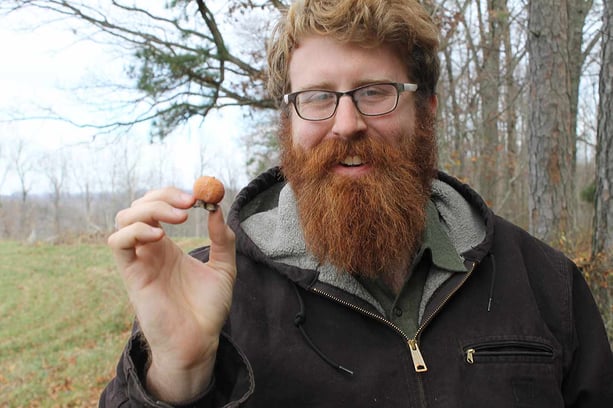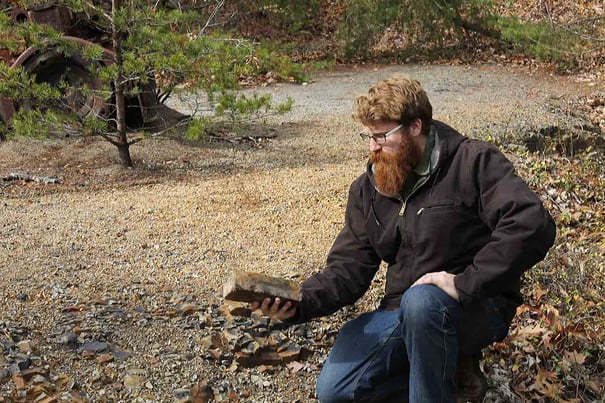I was driving along the Nantahala in late fall. The fog was thick, muting the sunset mauve colors of Oaks and Maples as they shed their leaves to prepare for the cold months. When I’d stopped for a walk I could pick out the lingering Sassafras leaves, grey panicles of the Hydrangea, and mammoth Muscadine vines growing towards the canopy. I spotted the barren branches and glowing fruit of the wild Persimmons, one of my favorite wild fruits. After a few moments of rooting around under the tree I was back on the road with a few fistfuls of the most ripe fruit I could find.
I grew up in the southern Appalachian Mountains. The mountains and valleys of our eastern deciduous forests are rich in some of our most valued botanicals. Plants like goldenseal, ginseng, black cohosh, and many others have played important ecological roles in our forests since ancient times. The long traditions of using these plants for good health continue to influence our modern approaches to herbalism and our relationship with these forests.
I visited Appalachia to talk with our wild-harvesters and ask what we can do to help manage and plan for our woodland harvests. With the growing interest of incorporating more of our woodland plants into our lives for health and food we need to continue to be engaged with where and how these plants are harvested and what we can do to ensure healthy future stands.
Non-timber forest products also provide growing business for rural economies. On a large organic forest farm we work with in Kentucky the signs of former industry are visible across the landscape. From the hills that had been clear cut and were growing back thick with Slippery Elm, to the rusted hulk of machinery used to make bricks from the clay that was quarried from the area, it is awesome to watch the family who’d lived on this land for generations move towards a more active stewardship of the property.
Working with the land to learn how to manage our forests for an indefinite harvest of these plants, we can also ensure the people who do this work have good livelihoods. As more people return to the forest for healing, it becomes our responsibility to ensure that we’re taking care of the plants and the people that these forests support. Intentionally growing and managing stands of medicinal, edible, and beautiful plants in forests is what we’re working towards.
Wild Cherry and Slippery Elm are two trees that I have been using for a long time. Several years ago some friends and I were clearing trees from a driveway out on wooded land in central Alabama. We cut down some black cherry trees and I spent the next couple days with a draw knife peeling back the fragrant bark. I gave most away and used enough for some tincture we’d all call “Throat Tickle” for it’s effectiveness in warming, soothing, autumn teas. I dried and cured the wood and used them to make walking sticks for me and my father and used the end cuts for a cutting board for my partner.
Wild Cherry pairs well with another tree that lives between the forest and the fields, Slippery Elm. For timber forest management Slippery Elm, or Red Elm, is usually considered an uneconomically important tree. It’s branching habit and quick growth doesn’t lend it to a lot of woodworking applications, but for many herbalists it's an invaluable resource as one of our most excellent mucilaginous demulcents.
Slippery Elm is threatened by two diseases: Dutch Elm Disease and Elm Yellows Disease. These diseases are spreading through our Appalachian forests threatening our elm stands. For the cottage-scale herbalist harvesting the spongy cambium only from windfall branches after a storm or making friends with a local saw mill to gather the bark after a cut seems to be the most ethical option. Often many small saw mills will give you or sell you the wood inexpensively just to take it away because it is considered not worth the effort to handle. It makes okay fire wood as well. However, cutting small strips from a tree can open up a large wound that could be infected by disease, spreading these threats through our forests. These useful trees take a few decades to grow to a harvestable size, so helping the forest industry recognize our use and value of them is important.
Mountain Rose is working with our forest farms to figure out the best strategies for continuing the harvest of these trees. These trees highlight some of the challenges of working with forest management of our older medicinal plants. For a general mucilaginous demulcent, many people have turned to marshmallow root. If you’d like to wild-harvest your slime-plants, here in the Pacific Northwest, I like to use our native weedy Malvaceae Sidalcea, often grown as a native ornamental, or the introduced Malva neglecta leaves. Some native or introduced Malvaceae can be found across the country. Where I’m from in the Deep South, hibiscus and okra grow very well. I also love Sassafras leaves in the Lauraceae family as a good aromatic mucilage, traditionally used to thicken gumbo.
Stopping at different natural and historic places throughout the South reminded me of the culture I come from and the long traditions of plants and an engagement with nature that shaped those cultures. I feel honored to work with our forest-harvesters to connect people with the most ethical and honest botanicals we can.
Brian’s Dirty South Throat Tickle Soother
Ingredients:
1 quart of pleasantly warm to hot organic slippery elm or marshmallow root tea
Raw local honey to taste
fresh organic grated ginger, garlic, or another warming aromatic to taste
3-4 droppers of organic cherry bark tincture
2-3 droppers of organic sassafras root tincture or some fresh fall sassafras twigs in the tea, excellent warm lemony flavor (optional) or organic lemon juice to taste (optional)
2-3 dropper organic echinacea root, teaberry leaf, or birch bark tincture (optional)
Bourbon to taste (very optional)
Directions:
Mix all ingredients together and sip as needed!














